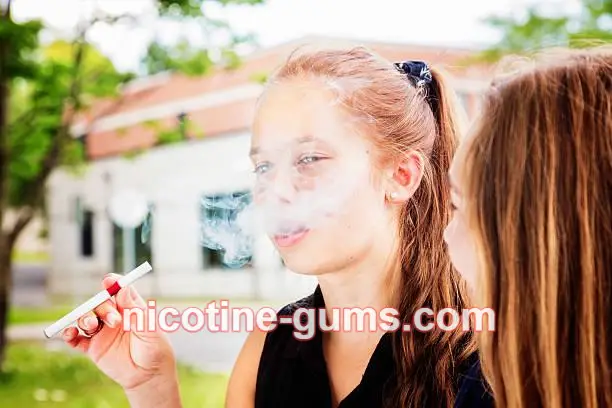UK Tackles Underage Nicotine Use: NHS Now Prescribes Nicotine Patches and Gum for Teens
The issue of underage smoking has been sparking serious concern across the globe, and the UK is stepping up its response by introducing a new measure aimed at helping teens quit nicotine. The National Health Service (NHS) in the UK is now offering nicotine replacement therapies like patches and gum to teenagers aged 12 and older, even though many of them are not yet old enough to legally purchase tobacco products. This bold move, announced in early January 2025, has already seen a significant number of young people benefiting from the treatment.
Nicotine Patch & Gum: A New Strategy to Combat Teen Addiction
As the prevalence of vaping and smoking continues to rise among teenagers, the NHS has decided to provide a solution that could help many struggling with nicotine addiction. In the first few months of the new policy, almost 1,300 young people have already been prescribed nicotine patches and gum by NHS healthcare professionals. This initiative is being introduced in an effort to address the growing problem of nicotine dependency, especially since many teenagers, despite not having the legal right to buy cigarettes or vapes, are becoming hooked on nicotine at an early age.
Nicotine replacement therapy, which includes patches and gum, is being prescribed to help teens manage withdrawal symptoms and reduce cravings as they work to quit. The move is part of a wider public health strategy to combat the rise in smoking and vaping among the younger population. While nicotine patches can cost up to £25 (roughly $30) on the NHS, nicotine gum prescriptions range from £2 to £10 (about $2.50 to $12) per supply, depending on quantity.
Although the legal smoking age in the UK is 18, and selling cigarettes or vapes to anyone under this age is illegal, NHS doctors are still providing these alternatives as part of a medical treatment plan for young people already struggling with addiction. The reasoning is that it’s better to offer teens a safer way to manage their cravings rather than let them continue smoking or vaping, which is far more harmful.
The Rising Trend of Teen Vaping and Smoking
According to NHS data, while only 2% of teens between 11 and 15 years old are active smokers, an alarming 11% have at least tried smoking. But the numbers for vaping are even more concerning. Around 9% of students are currently using vapes, with the figure for 15-year-old girls reaching a staggering 22%. This trend has experts worried, as vaping has been marketed as a safer alternative to traditional smoking, but it's becoming increasingly clear that it still carries significant health risks, especially for young people whose bodies are still developing.
The numbers are particularly concerning for health professionals like Sanjay Agrawal, a tobacco addiction specialist for the NHS. Agrawal voiced his concerns in a recent interview, saying, “Every day, 200 to 300 young people try smoking or vaping for the first time. And when you look at the stats, one in two long-term smokers will die from a tobacco-related disease. That’s a pretty scary thought for our young people.”
These numbers indicate that nicotine addiction among teens is not just a passing trend—it’s a full-blown epidemic that requires immediate action. Agrawal also expressed his support for the Tobacco and Vaping Bill, a proposed piece of legislation that would raise the legal age for purchasing tobacco and vaping products. This bill aims to curb access to these addictive substances among young people, while also providing increased support for those already struggling with addiction.
Why Vaping is So Popular Among Teens
One reason that vaping has become so popular among teenagers is the wide variety of flavors available. From fruity concoctions like mango and strawberry to more exotic flavors such as mint and cotton candy, there’s a vape flavor for everyone. While some might argue that flavored vapes make the product more appealing to younger audiences, others see it as a way to help adults quit smoking. However, the reality is that these flavors are luring teens into the world of nicotine use at an alarmingly young age.
Many teenagers see vaping as less harmful than smoking traditional cigarettes, which is partly due to how it's marketed. Vapes are often advertised as a "healthier" alternative to smoking, even though the long-term health effects are still largely unknown. Some teens also view vaping as a way to rebel or fit in with their peers, not realizing the risks involved. The accessibility of flavored vapes only adds to the allure. According to experts, the sweet and candy-like flavors create an enticing experience for teens, making them more likely to experiment with vaping.
However, this doesn't change the fact that vaping is not risk-free. Health professionals have warned that vaping still exposes the lungs to harmful chemicals, and regular use can lead to addiction. There is also the concern that nicotine, especially when introduced at a young age, can interfere with brain development, potentially leading to long-term cognitive and behavioral issues.
The Role of Social Media and Peer Influence
In today’s digital age, social media plays a huge role in shaping teen behavior. Platforms like TikTok, Instagram, and YouTube are filled with videos and posts showcasing vaping, often glamorizing the act and making it seem cool. In some cases, influencers promote vaping as a fun, trendy activity, which only further contributes to its normalization among younger audiences.
Peer influence is also a significant factor in why many teens try smoking or vaping. It’s not uncommon for a group of friends to encourage one another to try it, either out of curiosity or a desire to fit in. Unfortunately, this peer pressure can be overwhelming, especially for teenagers who are already dealing with social anxiety or the desire to be accepted.
The Bigger Picture: What’s Being Done to Address the Issue?
The NHS’s decision to prescribe nicotine patches and gum to teens is a step in the right direction, but it’s not the only solution. Governments around the world are beginning to take a closer look at the marketing tactics used by vaping companies and the accessibility of these products to minors. Many countries, including the US, are now pushing for stricter regulations on flavored vapes and advertising practices to prevent the normalization of nicotine use among young people.
In addition, schools and communities are ramping up educational efforts to teach teens about the risks of vaping and smoking. Anti-smoking campaigns are becoming more prevalent on social media, with many organizations working to reach younger audiences where they spend most of their time. The hope is that by raising awareness and providing the necessary resources, teens will be better equipped to make informed decisions about their health.
Conclusion: A Growing Crisis
While the NHS’s move to offer nicotine patches and gum to teens is a welcome intervention, it’s clear that the issue of teen smoking and vaping goes much deeper. To truly address this crisis, society must tackle both the availability of these products and the cultural factors that make them so appealing to young people. Only by providing teens with the support they need and the education to make healthier choices can we hope to reverse the tide of nicotine addiction among today’s youth.
As experts like Sanjay Agrawal suggest, the real solution lies not just in giving kids nicotine replacements, but in making sure they never start using nicotine products in the first place. But with the current state of teen vaping and smoking, the fight is far from over.
